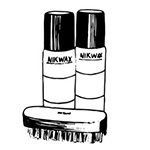
We've collated a few pointers below which may be helpful in selecting and maintaining your favourite footwear. A small amount of routine care can both prolong the life of your footwear and improve your enjoyment of them!
Selecting the Right Footwear
The first consideration when buying footwear is knowing what you need. For most people that just means choosing something that looks right and fits well. You should take more care when buying something for a specific purpose, as even though a shoe may look the part, it doesn't necessarily mean that it is suitable. Don't opt for a light cotton trainer if you want something to keep your feet dry!
The second and main consideration, is the fit of the footwear. Everyone's feet are different, and a shoe that pinches and rubs one person may fit another person perfectly. Take your time to try them on in our shop. Whether you buy from us in person at our shop, or online, you should try your footwear on at home (and we'd recommend trying them for about an hour) to help identify if the footwear is suitable for you before wearing them outside. Please note, once you've worn your shoes outside, under no circumstances can we take them back if they are uncomfortable or you have changed your mind.
Once you've decided on your footwear, remember that they may need wearing in. Don't wear your new shoes for a long walk straight away - break them in gradually, and for formal or sturdier shoes, you may need to soften them up by hand.
How Long Will They Last?
This is a very common question, and very difficult to answer. Most decent running shoes last for between 300 miles and 500 miles of running, but that's a pretty significant difference. As for fashion shoes or office shoes? It really is impossible to say. Any product should last a reasonable amount of time, but over the years we've seen the same pair of shoes last 6 months for one person and 15 years for another person.
There are a number of factors which determine how long footwear will last: Is the footwear suitable for the intended purpose? Does the footwear fit your foot? Is the footwear properly maintained? How often is the footwear used? How do you walk in the footwear? In what environment is the footwear used and stored? How often do you wear them?
Everything will wear away over time, stone, metal, and the soles on shoes! Footwear can wear from underneath (caused by friction with the surface on which you are walking or running), from the inside (caused by friction with your foot) and in construction (a combination of the environment, and how the footwear is cared for). Everyone's feet are also different, so wear will also vary depending on how you walk.
As you can't really determine how long footwear will last, the next best alternative is knowing how you wear your shoes and doing everything possible to preserve them!
Wet Weather:
Footwear is not waterproof unless clearly labelled on the product, and normally this will only be walking boots, but water-resistant footwear is perfectly satisfactory for most people's requirements.
As a general rule, the faux-leathers are water-resistant, which means they are totally fine to use in the rain, but the nature of how shoes are made means that most shoes wouldn't keep your feet dry if you are stood in a pool of water (something that will rise above the sole of your shoe) for a very long time.
The faux-suede, cotton, nylon and other non-leather-like materials require the application of a spray, cream or wax to improve water resistance, but the success of the water-proofer varies hugely between materials and styles of shoe. Ultimately you may just have to experiment.
Footwear can have their water-resistance improved through the application of spray (such as those we stock made by Nikwax) or polish/dubbin (which we have from Vegetarian Shoes).
Jogging / Running:
Fashion trainers may be comfortable to walk in, but are unlikely to be suitable if you're doing a lot of jogging or running. Purpose-made running shoes should be considered, as they are made to support and cushion your feet, to improve comfort and help prevent injury. At the moment the only trainers that we sell that are specifically made for running are by Norman Walsh, made in Bolton here in UK.
Walking / Rambling / Hiking:
Although a pair of chunky 8-hole boots may be okay for many purposes, they don't provide much ankle support, and water can still get round the sides of the tongue. Walking boots are designed specifically for your off-road adventures, to help protect your feet by providing a solid and comfortable sole (so you dont feel harsh surfaces), ankle support (to help avoid a twisted ankle) and a waterproof upper with a bellows tongue to keep your feet dry (if it is stated that the boot is waterproof).
Digging:
Durable or steel-toe footwear are often bought for gardening and working outdoors, but digging with a spade may cause a sole to split regardless of the overall quality of the boot. A boot with a steel-midsole is often the better choice.
Maintaining Your Footwear
Cleaning / Polishing:
Remove any dust or dirt with a clean cloth or by lightly brushing. For coarse or textured uppers such as faux-suede, avoid using a cloth made of a material that could collect on the shoe.
Marks can often be removed with a damp cloth or a pencil eraser on smooth uppers, and a suede brush/cleaner can be used for synthetic suede.
DO NOT put footwear into a washing machine (unless the manufacturer advises that it is safe to do so) as this is likely to seriously damage them.
Minor scuffs and cracks can often be filled/fixed with polish on synthetic leather footwear, and polish also helps to protect and improve the water resistance of footwear. It can also be worked with a cloth and/or a brush on synthetic leathers to produce a shiny finish.
Always remove any dust or dirt before polishing, and also remove your laces to avoiding staining them. Try the polish on a less visible area in case the finish is not to your liking. Apply polish evenly with a brush or soft cloth using circular strokes. Once the polish has completely dried, buff your shoes with a shoe polishing brush.
Drying:
Allow wet footwear to dry naturally in a well ventilated area as this will prevent any damage.
DO NOT dry your footwear near a fire or radiator as this will likely damage the uppers and cause the materials to separate.
You can use a shoe-tree to keep the shape of your shoes and help the dry, or alternatively you can stuff wet shoes with newspaper to do a similar job.
Shoe-horns:
Using a shoe-horn will protect the back of your footwear and help them last longer. Heel degradation is a common issue, particularly with casual and padded footwear.
Insoles:
Use of an insole can make a shoe (very approximately) half a size smaller, but it depends on the exact insole.
Regularly changing your insoles before wearing through them can protect the construction of your footwear, improve comfort, and provide extra warmth in winter and breathability in summer.
Water Resistance:
The materials used in the products on our website that look like leather are generally water resistant and can be used in wet weather.
Protect new shoes by spraying them with a water protector before wearing them for the first time.
Before you apply a water-resistance spray, remove any dust or dirt, then follow the instructions - often requiring the footwear to be wet.
The very front of the shoe is a key and often over-looked part of the shoe to protect as it is this part that will kick up water when walking. Always try the spray on a less visible area in case the material darkens and the finish is not to your liking. We sell NikWax sprays which are great for improving the water-resistance of footwear.
If you require footwear that can be worn in very heavy rain and is waterproof, please consider walking boots
Faux suede:
Faux suede and nubuck shoes require regular cleaning and waterproofing. Brush your shoes, use a traditional rubber suede eraser to remove marks, and then a suede brush to restore the nap of the fabric. Once cleaned you can generously spray with protector. We recommend (and sell) NikWax cleaner and waterproofer, but there's a huge selection available.
Storage:
Storing your footwear using a “shoe tree” will help maintain their shape and can help prolong their life. If you don't have a shoe-tree, you can stuff the toe of your shoes with newspaper.
The main benefit of a wooden shoe tree is the quick absorption of moisture away from the linings and insoles. Without a wooden shoe tree, the linings (and therefore the uppers) would lose this moisture slowly, and contract when the moisture leaves. The shrinking/expanding process that occurs without the use of shoe trees cause the linings to deteriorate much more quickly than they otherwise would.
Soles:
Remember that shoes will always wear down - like tyres on a car. It's a normal process, and you can take different approaches in managing that wear.
In addition, you may find that some shoes have a smooth resin sole when you buy them and you would prefer to have a cobbler fit an additional sole with more grip.
We've spoken to lots of cobblers about their recommendations and how often they re-heel their shoes and it varies hugely - from every two months to once a year. Ultimately it depends on the shoes, how you wear them and how well you look fter them.
Most footwear can be re-soled for a fraction of the cost of buying a new pair. Just don't wait until you've worn right through your soles!
We recommend finding a good cobbler to re-sole and re-heel your shoes, and you can speak to them before you've worn through them to get an idea of price, and at what point you should take them in for repair.
With a 'stacked' heel on a shoe or boot, you can often easily see when your heel needs to be replaced as the heel is comprised of multiple layers, the bottom one being rubber. You should re-heel before you wear through this rubber layer. If in any doubt, speak to a cobbler!
